Bosch SHE3AR52UC User Manual [en, es, fr]

Congratulations and thank you from Bosch!
Thank you for selecting a Bosch dishwasher. You have joined the many consumers who demand quiet and superior performance from their dishwashers.
This manual was written with your safety and convenience in mind, and the information contained herein is very important. We highly recommend that you read this manual before using your dishwasher for the first time.
To learn more about your dishwasher and available accessories, as well as many other top quality Bosch appliances, visit our web site at:
www.bosch-home.com/us (USA) or
www.bosch-appliances.ca (Canada)
If you have any questions or comments, please contact us at: 1-800-944-2904 or write us at:
BSH Home Appliances, Corp. |
|
5551 McFadden Avenue |
|
Huntington Beach, CA 92649 |
|
Table of Contents |
|
Important Safety Instructions.................................................... |
2-3 |
Dishwasher Components............................................................ |
4-5 |
Dishwasher Features and Materials.............................................. |
6 |
Loading the Dishwasher............................................................. |
7-8 |
Loading the Silverware Basket................................................... |
8-9 |
Rack Accessories........................................................................ |
10 |
Adding Detergent and Rinse Agent......................................... |
10-11 |
Dishwasher Cycles and Options.................................................. |
12 |
Wash Cycle Information.............................................................. |
12 |
Operating the Dishwasher...................................................... |
13-14 |
Care and Maintenance............................................................ |
14-15 |
Self Help................................................................................ |
16-17 |
Customer Service....................................................................... |
18 |
Warranty Information................................................................. |
19 |

IMPORTANT SAFETY INSTRUCTIONS: Please READ and SAVE this information
 WARNING
WARNING
Misuse of the dishwasher can result in serious injury or death. Do not use the dishwasher in any way not covered in this manual or for any purpose other than those explained in the following pages.
Severe product damage and/or injury could result from the use of unqualified service technicians or non-original replacement parts. All repairs must be performed by a qualified service technician using only original equipment factory replacement parts.
Electrical shock or fire could result if the electrical supply for the dishwasher covered in this manual is incorrectly installed or if the dishwasher has been improperly grounded. Do not use the dishwasher covered in this manual unless you are certain the electrical supply has been correctly installed or the dishwasher has been properly grounded.
Never use harsh chemicals to clean your dishwasher. Some chloride-containing products can damage your dishwasher and may present health hazards!
Only sanitizing cycles have been designed to meet the requirements of 6 for soil removal and sanitation efficacy. There is no intention, either directly or indirectly, that all cycles on a certified machine have passed the sanitization performance test.
NOTICE
Never use steam cleaning products to clean your dishwasher. The manufacturer will not be liable for the possible damages or consequences.
It is highly recommended for the end user to become familiar with the procedure to shut off the incoming water supply and the procedure to shut off the incoming power supply. See the Installation Instructions or contact your installer for more information.
NSF/ANSI 184 Certified residential dishwashers are not intended for licensed food establishments.
2

WARNING: To reduce the risk of fire, electrical shock, or serious injury, observe the following:
1This dishwasher is provided with Installation Instructions and this Use and Care Manual. Read and understand all instructions before using the dishwasher.
2This appliance must be grounded to a metal, permanent wiring system, or an equipment grounding conductor must be run with the circuit conductors and connected to the equipment grounding terminal or lead on the dishwasher. See the Installation Instructions included with this dishwasher for more information on electrical requirements.
3Use this dishwasher only for its intended function, which is the washing of household dishware and kitchenware.
4Use only detergents or rinsing agents recommended for use in a dishwasher, and keep them out of the reach of children.
5When loading items to be washed:
•Locate sharp items so they are not likely to damage the door seal.
•Load knives and other sharp utensils with their HANDLES UP to reduce the risk of cuttype injuries.
•Do not wash plastic items unless they are marked “dishwasher safe” or the equivalent. For plastic items not so marked, check the manufacturer’s recommendations.
•Do not operate your dishwasher unless all enclosure panels are in place.
•Do not tamper with or override controls and interlocks.
6Do not abuse, sit or stand on the door or dish racks of the dishwasher.
7To reduce risk of injury, do not allow children to play in or on the dishwasher.
8When children become old enough to operate the appliance, it is the legal responsibility of the parents/legal guardians to ensure the children are instructed in safe practices by qualified persons.
9Under certain conditions, hydrogen gas may be produced in a hot water system that has not been used for two weeks or more. Hydrogen gas is explosive. Before using a dishwasher that is connected to a hot water system that has been unused for two weeks or longer, turn on all hot water faucets and let the water flow from each for several minutes. This will release any accumulated hydrogen gas. As the gas is explosive, do not smoke or use an open flame during this time.
10Remove the dishwasher door to the washing compartment when removing an old dishwasher for service or discarding.
11To avoid floor damage and possible mold growth, do not allow wet areas to remain around or under the dishwasher.
12Protect your dishwasher from the elements. Protect against freezing to avoid possible damage to the fill valve. Damage caused by freezing is not covered by the warranty.
13For a cord-connect appliance:
•This appliance must be grounded. In the event of a malfunction or breakdown, grounding will reduce the risk of electric shock by providing a path of least resistance for electric current. This appliance is equipped with a cord having an equipment-grounding conductor and a grounding plug. The plug must be plugged into an appropriate outlet that is installed and grounded in accordance with all local codes and ordinances.
•Improper connection of the equipment-grounding conductor can result in risk of electric shock. Check with a qualified electrician or service representative if you are in doubt whether the appliance is properly grounded. Do not modify the plug provided with the appliance, if it will not fit the outlet, have a proper outlet installed by a qualified electrician.
3

Dishwasher Components
SHE3AR7xUC*
SHE3ARFxUC*
SHE3AR5xUC*
SHE3ARLxUC*
* “x” can be any number
4
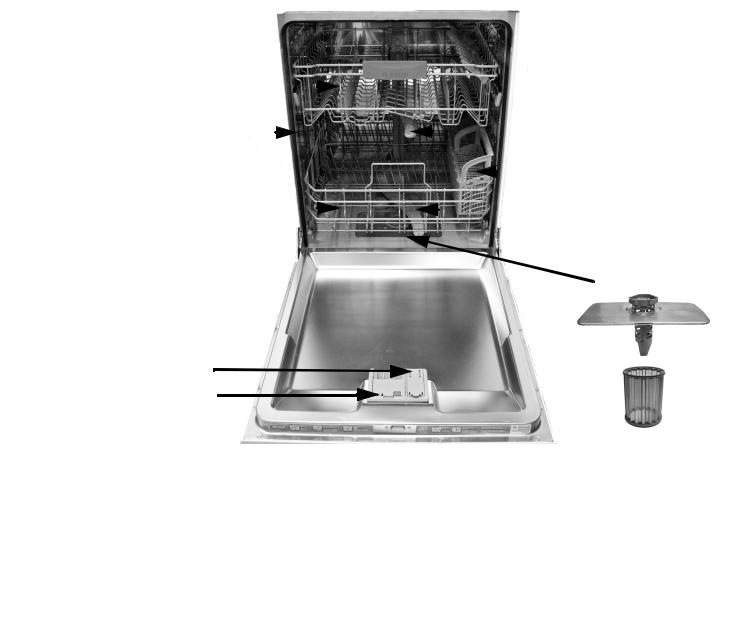
Top rack |
|
|
|
|
|
|
|
|
|
Top rack spray arm |
|
|
|
|
|
|
|
|
|
|
|||
Vent |
|
|
|
|
|
|
|
|
|
||
|
|
|
|
|
|
||||||
Bottom rack |
|
|
|
|
|
|
|
|
Silverware basket |
||
|
|
|
|
|
|
|
|||||
|
|
|
|
|
|
|
|
||||
|
|
|
|
|
|
Bottom rack spray arm |
|||||
|
|
|
|
|
|
|
|||||
Filter system
Rinse aid dispenser
Detergent dispenser
|
|
|
Wash Cycles |
|
|
|
|
Additional Features |
|
|
||||
Model |
Heavy |
Auto |
Normal |
Delicate |
Express |
Half |
Rinse & |
Adjustable |
Child |
Delay |
Flip |
Sanitize Silverware |
||
Wash |
Wash |
Wash |
Wash |
Wash |
Load |
Hold |
Top Rack |
Lock |
Start |
Tines |
Option |
Basket |
||
|
||||||||||||||
|
|
|
|
|
|
|
|
|
|
|
|
|
|
|
SHE3AR7xUC* |
X |
X |
X |
X |
X |
X |
|
X |
X |
X |
X |
X |
Standard |
|
|
|
|
|
|
|
|
|
|
|
|
|
|
|
|
SHE3ARFxUC* |
X |
X |
X |
X |
X |
|
X |
X |
X |
X |
X |
X |
Flexible |
|
|
|
|
|
|
|
|
|
|
|
|
|
|
|
|
SHE3AR5xUC* |
X |
X |
X |
|
|
X |
|
|
X |
X |
|
X |
Standard |
|
|
|
|
|
|
|
|
|
|
|
|
|
|
|
|
SHE3ARLxUC* |
X |
X |
X |
|
X |
X |
|
|
X |
X |
|
X |
Standard |
|
|
|
|
|
|
|
|
|
|
|
|
|
|
|
|
* “x” can be any number
5
Dishwasher Features
Auto-Close: The auto-close feature will hold the door wherever you place it and then automatically latch when open 20 degrees or less.
Delay Start: Delay the start time of your dishwasher using the delay start option.
EcoSense™ Wash Management System: Checks water condition and decides if a second fresh water fill is necessary.
Extra Dry Heat: Raises the temperature of the rinse and increases the drying time resulting in improved drying.
Flow-Through Heater™: heats water to a sanitizing temperature.
Noise Reduction System: uses Suspension Motor™, a two-pump motor system, and insulation to make this dishwasher one of the quietest in North America.
Nylon Coated Racks: eliminates cuts and nicks and have a five year warranty.
OptiDry™: This feature senses when the unit is low on rinse agent and automatically increases the drying time.
SaniDry™: A high temperature final rinse, a low temperature stainless steel tub and the sheeting action of a rinse agent result in drying that is hygenic, energy efficient and economical.
Sanitize: An option to meet sanitized conditions. This option can only be used with certain wash cycles. See page 12.
Triple Filtration System: uses multiple filters to ensure distribution of clean water and protect the main pump and the drain pump from foreign material.
Model dependent features:
Adjustable Rack: The top rack can be raised or lowered manually to accommodate tall items in the top and bottom racks.
Flip Tines: increase the rack flexibility to accommodate larger/taller items.
Dishware Materials
Note: Before using your dishwasher for the first time, check the information in this section. Some items are not dishwasher safe and should be hand washed; others require special loading.
Recommended
Aluminum: Colored anodized aluminum may fade over time. Minerals in your water may cause the aluminum to darken or spot. This can usually be removed with a soap-filled steel wool pad.
China, Crystal, Stoneware: Some hand-painted utensils may discolor, fade or spot. Hand wash these utensils. Position fragile glassware so that it will not topple over or come in contact with other utensils during the wash cycle.
Glass: Milk glasses may discolor or become yellow.
Non-stick Coatings: Apply a light coating of vegetable oil to non-stick surfaces after drying. Plastics: Make sure the plasticware is dishwasher safe.
Stainless Steel, Sterling Silver and Silver Plates: Load these so they do not come in contact with other metals.
Not Recommended
Acrylic: Crazing, small cracks throughout the acrylic, may occur.
Adhesive-Joined Pieces: Adhesives that join materials such as plastic, wood, bone, steel copper, tin, etc. may loosen.
Bone-Handled Utensils: Handles may separate.
Iron: Iron will rust. Hand wash and dry immediately.
Non-Dishware Items: Your dishwasher is intended for use in cleaning ONLY standard household dishware and kitchenware.
Pewter, Brass, Bronze: These items will tarnish. Hand wash and dry immediately. Tin: Tin will stain. Hand wash and dry immediately.
Wood: Wooden bowls, wooden utensils and utensils with wooden handles can crack, warp and lose their finish.
6

Loading the Dishwasher
Do not pre-wash items with loosely attached soiling. Remove all food particles, bones, toothpicks and excessive grease. Items having burned-on, baked-on or starchy soils may require some pretreatment. Refer to the Dishware Materials section for more information about dishware suitability.
Load only dishwasher safe items into the dishwasher. Load dishes in the dishwasher racks so the insides of bowls, pots and pans are facing the spray arms. Avoid nesting and contact points between dishes. Separate items of dissimilar metals.
Loading the Top Rack
Ensure items do not protrude through the bottom of the racks and block the spray arms.
Note: When pushing the top rack into the dishwasher, push it until it stops against the back of the tub so the top rack spray arm connects to the water supply at the back of the tub. Do not push racks in using the door.
Loading the Bottom Rack
Place large items in the bottom rack. Load pots, pans and bowls upside down. Do not block vent with tall baking sheets. Load these items on the left side of the dishwasher.
Unloading the Dishwasher
When unloading the dishwasher it is best to unload the bottom rack first. Next, unload the silverware basket followed by the top rack.
NOTICE
To avoid dishwasher damage, do not load the dishwasher with paper products, plastic bags, packing materials or anything other than normal, dishwasher safe dishware and kitchenware.
Suggested Loading Pattern - Flexible Silverware Basket
Top Rack Bottom Rack
Additional Loading Pattern - Flexible Silverware Basket (10 place settings)
Top Rack Bottom Rack
7
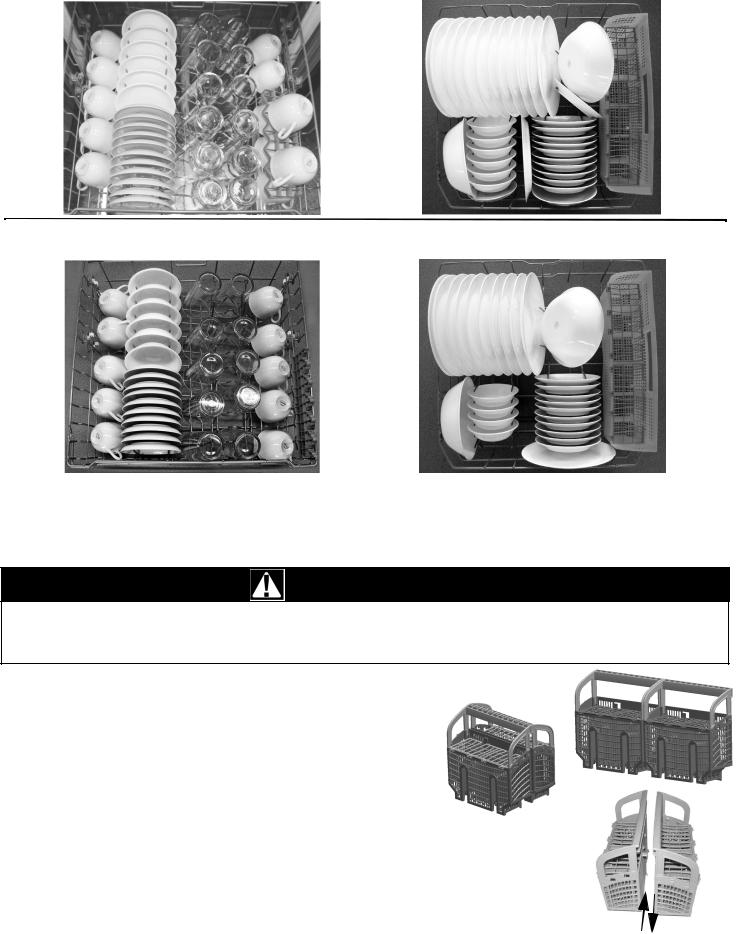
Suggested Loading Pattern - Standard Silverware Basket
Top Rack Bottom Rack
Additional Loading Pattern - Standard Silverware Basket (10 place settings)
Top Rack Bottom Rack
Loading the Silverware Basket
Place knives and sharp utensils with their HANDLES UP and forks and spoons with their handles down. If large or oddly-shaped items are loaded in the silverware basket, be sure they do not nest together.
WARNING
The sharp points and edges of knives and other sharp utensils can cause serious injury. Load knives and other sharp utensils with edges down. Do not allow children to handle or play near knives and sharp utensils.
The Flexible Silverware Basket (select models)
This basket splits along its length, resulting in two halves that may be placed in a variety of positions in the lower rack, greatly increasing the lower rack’s loading versatility. The basket snaps together either back to back or end to end as shown below.
To split the Flexible Silverware Basket
Grasp the basket and slide the two halves in opposite directions as shown at right and then pull the two halves apart.
8
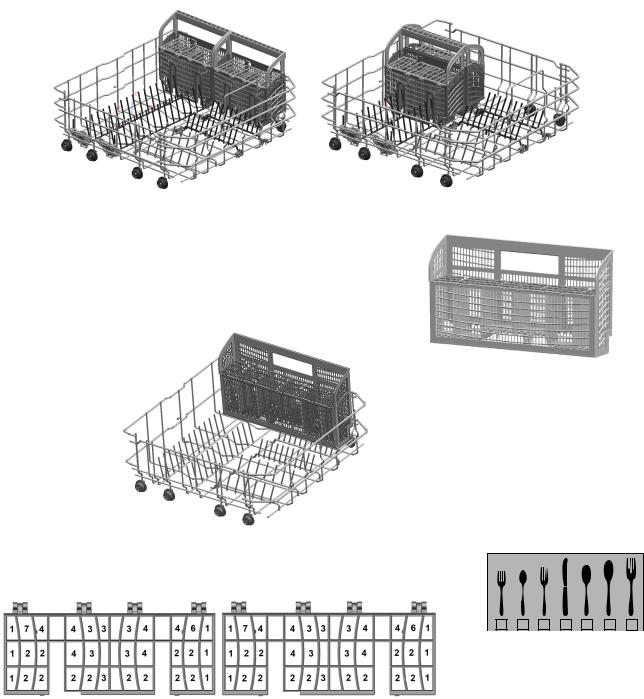
Flexible Basket Placement Options
The Standard Silverware Basket (select models)
The standard silverware basket fits along the side of the lower rack.
Standard Basket Placement Option
Loading pattern for Flexible & Standard Silverware Baskets
|
|
1 |
|
2 |
|
|
3 |
|
4 |
|
5 |
|
6 |
|
7 |
|
|
|
|
|
|
|
|
|
|
|
|
|
|
|
|
|
|
|
|
1- salad fork |
|
5 |
- tablespoon |
||||||||||||||
2- teaspoon |
|
6 |
- serving spoon |
||||||||||||||
3- dinner fork |
7 |
- serving fork |
|||||||||||||||
4- knife |
|
|
|
|
|
|
|
|
|
|
|
|
|
|
|
||
The basket lid may also be snapped to the handle in order to leave the basket open.
9
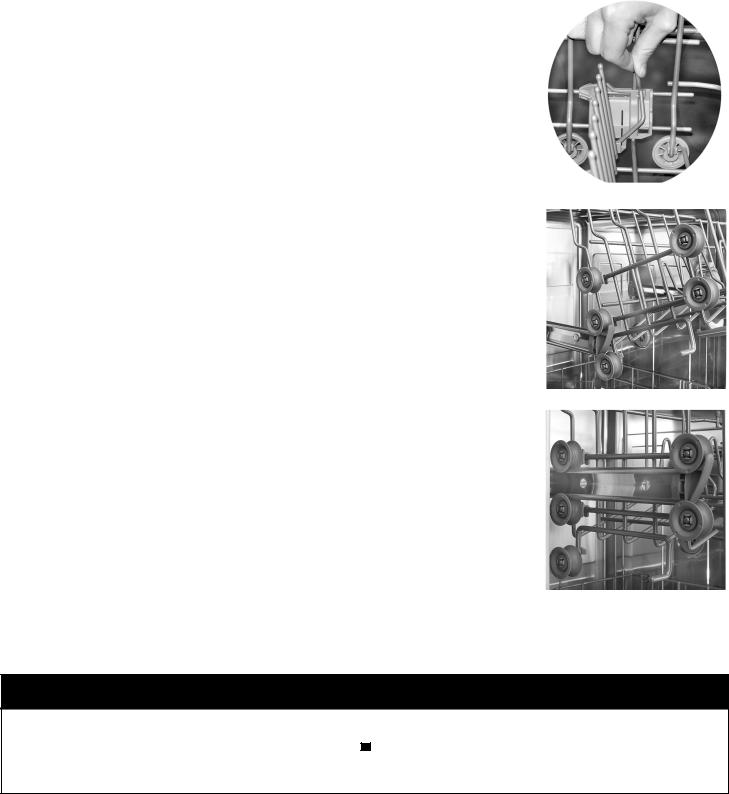
Rack Accessories
Flip Tines (model dependent)
The racks consist of tines that can be folded down depending on what you may need to load in the rack. To fold down, grasp the folding tine and release from notch. Push folding tine downward to desired position as shown in Figure 1.
Adjustable Upper Rack (model dependent)
Remove the empty upper rack by pulling it out of the dishwasher until it can be lifted upward as show in Figure 2. Pull the rack up and out until the rollers are completely free of the roller guides.
Reinsert the rack with the other set of rollers on the roller guides as shown in Figure 3.
Adding Detergent and Rinse Agent
Detergent
Figure 1
Figure 2
Figure 3
Use only detergent specifically designed for dishwashers. For best results, use fresh powdered dishwashing detergent.
NOTICE
To avoid dishwasher damage, do not use hand dishwashing products in your dishwasher.
To avoid dishwasher damage, do not use too much detergent if your water is soft. Using too much detergent with soft water may cause etching in glassware.
The dishwasher uses less water, therefore, less detergent is required. With soft water, 1 tablespoon (15ml) of detergent will clean most loads. The detergent dispenser cup has lines that measure detergent to 1 tablespoon (15ml) and 1.75 tablespoons (25ml). 3 tablespoons (45ml) of detergent will completely fill the detergent dispenser.
Note: If you do not know the hardness of your water supply, use 15ml of detergent. Increase the amount if necessary to the least amount required to get your kitchenware clean.
Use the measuring lines in the detergent dispenser cup as a guide to measure the amount of detergent recommended in Table 1.
10

Adding Detergent
•1 tablespoon (15ml) will clean most loads (see Figure 4).
•Do not use more than 3 tablespoons (45ml).
•Do not over fill the detergent dispenser.
•When using detergent tabs, lay them flat to avoid contact with the cover.
To Close
•Place finger as shown in Figure 5.
•Slide door closed and press down firmly until it clicks.
To Open
•To open the cover, push the button as shown in Figure 6.
•Cover will slide open.
Table 1 - Recommended Detergent Amount
Wash Cycle |
Hard Water/ |
Medium Water/ |
Soft Water/ |
|
Heavy Soil |
Medium Soil |
Little Soil |
||
|
||||
|
|
|
|
|
Heavy |
45ml (3tbsp) |
45ml (3tbsp) |
25-45ml (1.75-3tbsp) |
|
|
|
|
|
|
Auto |
25-45ml (1.75-3tbsp) |
25ml (1.75tbsp) |
15-25ml (1-1.75tbsp) |
|
|
|
|
|
|
Normal |
25-45ml (1.75-3tbsp) |
25ml (1.75tbsp) |
15-25ml (1-1.75tbsp) |
|
|
|
|
|
|
Delicate |
25ml (1.75tbsp) |
15-25ml (1-1.75tbsp) |
15ml (1tbsp) |
|
|
|
|
|
|
Express |
25ml (1.75tbsp) |
15-25ml (1-1.75tbsp) |
15ml (1tbsp) |
|
|
|
|
|
|
Half Load |
25ml (1.75tbsp) |
15-25ml (1-1.75tbsp) |
15ml (1tbsp) |
|
|
|
|
|
|
Rinse & Hold |
None |
None |
None |
|
|
|
|
|
Rinse Aid
To achieve proper drying, always use a liquid rinse aid, even if your detergent contains a rinse aid or drying additive.
Note: The dishwasher indicates low rinse aid by turning on the Rinse Aid indicator light. If this light is on, you need to refill the rinse aid dispenser by following the directions below.
Adding Rinse Aid
Add liquid rinse aid to the dispenser until the reservoir is full (see Figure 7). Wipe up any excess rinse aid that may puddle when the dispenser reservoir is full. The indicator light will go out a few moments after the dishwasher door is shut. See pages 13 or 14 for instruction on how to adjust the amount of rinse aid dispensed.
Figure 4
3Tbsp. Max.
2Tbsp. (25ml)
1Tbsp. (15ml)
Figure 5
Figure 6
Figure 7
11
Dishwasher Cycles and Options
Wash Cycles (model dependent)
Heavy Wash: Best for cleaning items with baked-on food or grease. These dishes would normally require soaking.
Auto Wash: With our most complex soil sensing capability, this cycle is perfect for use with mixed loads of dishware with varying amounts of food soil. This is the most flexible cycle and is a good choice for everyday use.
Normal Wash: Thoroughly cleans a full load of normally soiled dishes.
Note: The Energy Guide Label was based on this soil sensing cycle will all available options turned off. As prescribed in the energy test procedure, the unit was tested without any Rinse Aid in the Rinse Aid dispenser. A single dose of detergent was used in the Detergent Dispenser, with no detergent used in the prewash. The test was conducted with the upper rack in the highest position.
Delicate Wash: For delicate or heirloom dishware and silverware or other special items. Always make sure that the items are dishwasher safe. Refer to the Dishware Materials section of this manual for further information. Hand washing may be the best treatment for such items.
Express Wash: Cleans lightly soiled dishes and reduces overall wash time. Use this cycle to clean glasses and dessert dishware that may need to be reused at the same event.
Half Load: Can reduce the energy and water consumption when washing small, lightly soiled loads that fill approximately half of the dishwasher’s capacity.
Rinse & Hold: Allows you to rinse food soil off of a partial load and hold them in the dishwasher until you are ready to run a full load.
Wash Cycle Options
Delay Start: Allows you to delay the start time of your dishwasher by 3, 6 or 9 hours.
Sanitize: The Sanitize feature is available only in the Heavy, Auto, Normal and Half Load cycles. Press the “Sanitize” button to activate the Sanitation features during these cycles. The sanitize LED will light when sanitation requirements are met. The technical sanitation measures may also improve the drying results.
Note: The dishwasher automatically defaults to Auto Wash when turned off and back on. If you used the sanitize option in your last cycle, the dishwasher will default to Auto Wash with the Sanitize option selected when you turn it on.
Wash Cycle Information
Note: To save energy, this dishwasher has a “Smart Control” where the sensors in the dishwasher automatically adjust the cycle length, temperature and water changes based on the amount of food soil and the incoming water temperature. The “Smart Control” makes decisions that can cause the cycle time and water usage to adjust intermittently. Wash cycle times are based on 120°F water supply. If your household water supply is higher than 120°F, your dishwasher’s heating time may be reduced and the “Sanitized” light or symbol may not illuminate.
Table 2 - Wash Cycle Information
|
Heavy Wash |
Auto Wash |
Normal Wash |
Delicate Wash |
Express Wash |
Half Load |
Rinse & Hold |
|
|
|
|
|
|
|
|
cycle time |
130 min |
105-119 min |
95-115 min |
80 min |
30 min |
99-110 min |
9 min |
|
|
|
|
|
|
|
|
cycle time with Sanitize |
150 min |
125-140 min |
120-140 min |
not available |
not available |
120-130 min |
not available |
|
|
|
|
|
|
|
|
water consumption |
25.6 L |
13.6-22.6 L |
8.7-19.5 L |
11.3 L |
11.3 L |
10.5-15.9 L |
4 L |
|
6.8 gal |
3.6-6 gal |
2.3-5.2 gal |
3 gal |
3 gal |
2.8-4.2 gal |
1 gal |
|
|
|
|
|
|
|
|
wash temperature |
71°C |
55-66°C |
50-55°C |
50°C |
45°C |
55-66°C |
no wash |
|
160°F |
130-150°F |
122-131°F |
122°F |
113°F |
130-150°F |
|
|
|
|
|
|
|
|
|
rinse temperature |
72°C |
65-72°C |
65-69°C |
69°C |
50°C |
65-72°C |
incoming |
|
162°F |
149-162°F |
149-156°F |
156°F |
122°F |
149-162°F |
water temp. |
|
|
|
|
|
|
|
|
Note: Only sanitizing cycles have been designed to meet the requirements of 6 for soil removal and sanitization efficacy. There is no intention, either directly or indirectly, that all cycles have passed sanitization performance tests.
12
Operating the Dishwasher
Start the dishwasher:
1Press the On/Off button.
2 One of the wash cycle LEDs will be flashing. You can now select a wash cycle. 3 Press the Cycle Select arrow buttons to select the desired wash cycle.
4Press Start to begin the cycle.
Delay start:
1 Press the On/Off button.
2Select a cycle.
3Press the Delay Start button. Release when the desired delay time is shown in the display window or the appropriate LED is lit (depending on model).
4Press Start to begin the cycle.
Cancel a cycle:
1Press and hold Start for 3 seconds.
2 Wait about 1 minute until the “Clean” LED illuminates, indicating it is done draining.
3Press the On/Off button. You may now start a new cycle.
Child Lock:
1After starting a cycle you can activate the Child Lock.
2Press and hold the < button until the “Child Lock” LED illuminates or “CL” appears on the display. “CL” disappears from screen when button is released.
3Child Lock is now active and buttons will not function, except On/Off.
4To deactivate, press and hold the < button until the “Child Lock” LED turns off or “CL” disappears from the display.
For models with display:
To enter options mode:
1With the door closed, press the On/Off button to turn the unit on.
2The countdown display and one of the wash cycle LEDs will be flashing.
3 Press and hold down the > button, then press and release the Start button. Now release the > button. 4 The “Sanitized” LED will be flashing. You are now in options mode.
5Press the > button to select the option you would like to adjust.
To set amount of Rinse Aid:
Note: If your glasses have spots on them, you need more rinse aid. If your glasses have streaks on them, you need less rinse aid.
1Follow the prior instructions to enter options mode.
2With the display showing “r:00” - “r:06” press the < button to change the amount of rinse aid dispensed.
r:00 = rinse aid is OFF
r:03 = medium amount of rinse aid dispensed r:06 = highest amount of rinse aid dispensed
3Press Start to save your setting.
To turn Extra Dry Heat ON or OFF:
1Follow the prior instructions to enter options mode.
2 With the display showing “d:00” or “d:01” press the < button to turn Extra Dry Heat ON or OFF. d:00 = Extra Dry Heat is OFF
d:01 = Extra Dry Heat is ON
3Press Start to save your setting.
13

For models without display:
To enter options mode:
1 With the door closed, press the On/Off button to turn the unit on.
2One of the wash cycle LEDs will be flashing.
3 Press and hold down the > button, then press and release the Start button. Now release the > button. 4 The “Clean” and one other LED will be flashing. You are now in options mode.
5Press the > button to select the option you would like to adjust.
To set amount of Rinse Aid:
Note: If your glasses have spots on them, you need more rinse aid. If your glasses have streaks on them, you need less rinse aid.
1Follow the prior instructions to enter options mode.
2With the “Clean” and “Rinse Aid” LEDs flashing, press the < button to change the amount of rinse aid dispensed.
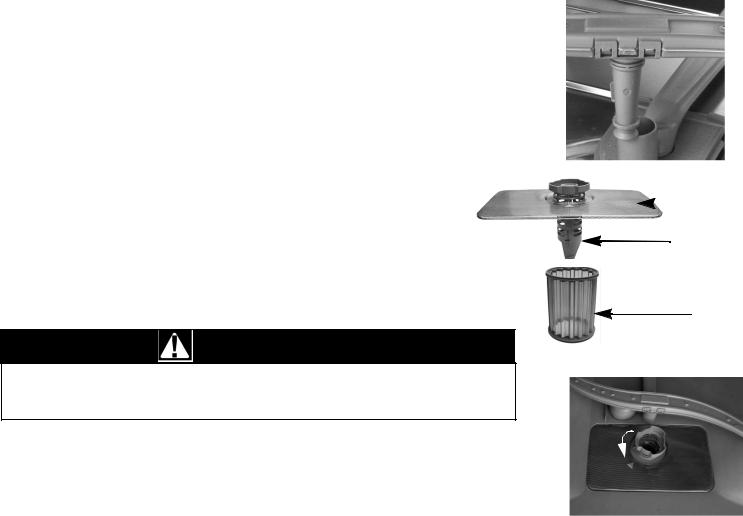
To reinstall the top spray arm, place it back in position and return the locking nut to its install position. Turn the locking nut clockwise to secure. Return the top rack to the top rack roller guides.
Remove the bottom spray arm by first removing the empty bottom rack from the dishwasher. Grasp and lift the spray arm as shown in Figure 9. Look for obstruction in the spray nozzles. If the spray nozzles need cleaning, flush them under running water.
To reinstall the bottom spray arm, return the bottom spray arm to the installed position and press it until it snaps into place. Return the bottom rack to the installed position.
Check and clean the filter system
The filter system consists of a Large Object Trap, Fine Filter and a Micro Filter.
The filter system is located on the inside of your dishwasher under the lower rack and is easily accessible. During normal use, the filter system is self-cleaning. You should occasionally inspect it for foreign objects and clean it when necessary.
CAUTION
To avoid injury, do not reach into the large object trap with your fingers. The large object trap could contain sharp objects.
To remove the Large Object Trap, remove the bottom rack. Grasp the assembly and turn it counterclockwise as shown in Figure 10. Lift the assembly out.
Carefully examine the assembly. If you find debris in the Large Object Trap, turn it upside-down and gently tap it on a flat surface to dislodge and remove debris.
Flush the Micro Filter clean by holding it under running water.
Figure 9
Fine

 Filter
Filter
Large Object
Trap
Micro
Filter
Figure 10
To reinstall the filter system, return the fine filter to the installed position. Turn the locking nut clockwise until it is locked. The arrow on the ring handle and the arrow on the Fine Filter should point at each other.
Clean the exterior door panel
Colored doors: use only a soft cloth dampened with soapy water.
Stainless steel doors: use a soft cloth with a non-abrasive cleaner (preferably a liquid spray) made for cleaning stainless steel. For the best results, apply the stainless steel cleaner to the cloth and then wipe the surface.
Clean the door gasket
Regularly clean the door gasket with a damp cloth to remove food particles and other debris. Also clean the door seal, located inside the dishwasher at the bottom of the door.
Winterizing your unit
If your dishwasher will be unused for an extended period of time in a location that experiences freezing temperatures (holiday home or through a vacation period), have your dishwasher winterized by an authorized professional service. Turn your household water supply to the dishwasher off when on extended vacation or when dishwasher will not be used for more than 1 month.
15

Self Help
Dishwashers may occasionally exhibit problems that are unrelated to a malfunction of the dishwasher itself. The following information may help you with a dishwasher problem without involving a repair professional.
Problem |
Cause |
Action |
|
|
|
Auto-Close door not closing properly
1. Auto-close feature will not work properly if dishwasher is not installed correctly.
1. Ensure the alignment of the dishwasher frame is accurate and level.
|
1. |
Door may not be properly latched |
1. |
Shut the door completely |
|
2. |
Unit may not be turned on |
2. |
Press the main power switch to turn unit on |
|
3. |
Unit not reset or previous cycle not com- |
3. |
To reset, refer to “cancelling or changing cycle” in this |
|
pleted |
manual |
||
Dishwasher |
4. Delay start engaged |
4. |
To reset, refer to “delay start” section in this manual |
|
does not start |
5. Interruption of electrical power supply to |
5. |
Check circuit breaker |
|
|
dishwasher or blown fuse. |
6. |
Select a cycle and close the door. |
|
|
6. |
The door may have been closed without |
7. |
Check and turn on water supply |
|
first selecting a cycle |
|
|
|
|
7. |
Water supply may not be turned on |
|
|
Dishwasher |
1. Default factory settings alert the cus- |
beeping (end |
tomer that the cycle is complete by beeping. |
of cycle sig- |
This feature can be deactivated if so |
nal) |
desired. |
1. To adjust the volume or deactivate, refer to the “cycle completion signal” section in this manual.
Display does |
1. |
A fuse may have been blown or circuit |
1. |
Check the fuse or circuit breaker box and replace the fuse |
not illuminate |
breaker tripped |
or reset the breaker if necessary |
||
or console |
2. |
Door not closed or latched |
2. |
Ensure door is properly latched and completely closed |
lights are not |
Note: For models with controls on top of the |
|
|
|
on |
door, the display only illuminate when the |
|
|
|
|
door is opened and controls are visible. |
|
|
|
|
|
|
|
|
Dishwasher |
1. |
Incoming water is not warm enough |
1. |
Before starting a cycle, run hot water faucet at the sink |
seems to run |
2. Cycle time can vary due to soil and water |
closest to the dishwasher |
||
a long time |
conditions |
2. Sensors in the dishwasher automatically increase the cycle |
||
|
3. |
Rinse agent dispenser is empty |
time to ensure a good wash when heavy soil is detected |
|
|
4. |
Dishwasher connected to cold water sup- |
3. |
Add rinse agent |
|
ply |
4. |
Verify dishwasher is connected to hot water supply plumb- |
|
|
Note: Refer to “wash cycle information” sec- |
ing |
||
|
tion in this manual for typical cycle lengths |
|
|
|
|
|
|
|
|
Dishes are not |
1. |
Spray arm movement obstructed |
1. |
Ensure that spray arm movement is not blocked by hand |
getting clean |
2. |
Spray arm nozzles clogged |
rotating spray arms before starting cycle |
|
enough |
3. |
Improper use of detergents |
2. |
Remove the spray arms and clean according to the “care |
|
4. |
Filters could be clogged |
and maintenance” section of the manual |
|
|
5. |
Dishes are nested or loaded too close |
3. |
Increase or decrease detergent depending on the water |
|
together |
hardness (refer to Table 1) |
||
|
6. |
Selected wash cycle is not suitable for |
4. |
Clean the filters according to the “care and maintenance” |
|
food soil conditions |
section of the manual |
||
|
|
|
5. Rearrange load such that water spray can reach all items in |
|
|
|
|
the dishwasher - see “loading the dishwasher” section of the |
|
|
|
|
manual |
|
|
|
|
6. |
Refer to “wash cycle information” section of the manual |
|
|
|
|
|
Dishes are not |
1. |
Rinse agent dispenser is empty |
1. |
Add rinse agent - the use of rinse agent improves drying |
getting dry |
2. |
Improper loading of dishes |
2. |
Rearrange load to ensure items are not nesting (see “load- |
enough |
3. |
Selected cycle does not include drying |
ing the dishwasher” section of the manual) |
|
|
4. |
Extra Dry Heat is not activated |
3. |
Rinse and Hold setting does not include drying |
|
Note: Plastic or Teflon do not typically dry |
4. See the “Operating the Dishwasher” section of this manual |
||
|
as well as other items due to their inherent |
to learn how to activate Extra Dry Heat |
||
|
properties |
|
|
|
|
|
|
|
|
16

Problem |
Cause |
Action |
|
|
|
Odor |
1. Food debris is present at the bottom of |
|
|
the dishwasher |
|
|
2. |
Food particles are present near the door |
|
seal |
|
|
3. Dishes left in unit too long before running |
|
|
a cycle |
|
|
4. |
Residual water is present at the bottom |
|
of the dishwasher |
|
|
5. |
Drain hose is obstructed |
1.Remove the filters and clean according to the “care and maintenance” section of the manual
2.Refer to “care and maintenance” section of the manual
3.Run a Rinse and Hold cycle if you do not intend to immediately wash the dishes
4.Ensure the unit has completely drained from the last cycle
5.Remove any obstructions from the drain hose by calling qualified personnel.
Note: If odor still persists, run the Normal/Regular cycle until it flushes and interrupt the cycle and place an 8oz. cup of distilled white vinegar solution on the top rack and then finish the cycle.
Dishwasher |
1. Restriction in the water supply system |
1. Ensure that the water supply valve (typically located under |
|
not filling with |
2. Previous wash cycle was not completed |
kitchen sink) is open and check that the water supply line has |
|
water |
3. Delay start is active |
no kinks or clogs |
|
|
4. Household water supply turned off |
2. |
Refer to the “operating the dishwasher” section of the |
|
|
manual. |
|
|
|
3. |
Cancel the delay start or wait until delay start time com- |
|
|
pletes |
|
|
|
4. |
Turn household water supply on |
|
|
|
|
Water leaks |
1. Suds |
1. |
Wrong type of detergent results in suds and leaks - use |
|
2. Door seal could be pulled away from |
only dishwasher detergents. If suds still persist, add one |
|
|
track |
tablespoon of vegetable oil at the bottom of the dishwasher |
|
|
3. Condensation vent is blocked |
and run the desired cycle. |
|
|
4. Improper installation |
2. |
Ensure the door seal is in the track |
|
|
3. |
Ensure that condensation vent is not blocked |
|
|
4. |
Have proper installation verified by qualified personnel |
|
|
(water supply, drain system, leveling, plumbing) |
|
|
|
|
|
Tub stains |
1. Stains on the dishwasher interior are due to |
1. |
Concentrated lemon juice can reduce the build up of hard |
|
water hardness |
water stains. Run a Regular cycle until it flushes and interrupt |
|
|
2. Silverware in contact with tub |
the cycle and then place an 8oz. cup of the concentrated |
|
|
|
lemon solution on the top rack and finish the cycle. this can |
|
|
|
be done periodically to avoid build up. |
|
|
|
2. Ensure that silverware does not make contact with the tub |
|
|
|
while running a cycle. |
|
|
|
|
|
Streaks on |
1. Incorrect rinse agent setting |
1. Depending on the hardness of water, adjust the rinse agent |
|
glassware or |
|
dispenser. Refer to “Operating the Dishwasher” section in |
|
residue on the |
|
the manual |
|
dishes |
|
|
|
|
|
|
|
Fascia panel |
1. Abrasive cleaner used |
1. |
Use mild detergents with soft damp cloth |
discolored or |
|
|
|
marked |
|
|
|
|
|
|
|
Noise during |
1. Dishes may not be arranged properly |
1. Water circulation sound is normal, but if you suspect items |
|
wash cycle |
|
are banging into each other or into the spray arms, refer to |
|
|
|
the “loading the dishwasher” section of the manual for opti- |
|
|
|
mal arrangement. |
|
|
|
|
|
Detergent dis- 1. Improper operation of detergent cover |
1. |
Refer to “adding detergent and rinse agent” section of the |
|
penser cover |
2. Previous cycle has not been finished or |
manual for instructions on opening and closing the dispenser |
|
will not shut |
rest or cycle or interrupted |
2. |
Refer to the “operating the dishwasher” section of the |
|
|
manual |
|
|
|
|
|
Unable to |
1. Previous cycle has not finished |
1. Refer to the “operating the dishwasher” section of the |
|
select desired |
|
manual |
|
cycle |
|
|
|
|
|
|
|
17

Customer Service
Your Bosch dishwasher requires no special care other than that described in the Care and Maintenance section of the manual. If you are having a problem with your dishwasher, before calling for service please refer to the Self Help section of the manual. If service is necessary, contact your dealer or installer or an authorized service center. Do not attempt to repair the appliance yourself. Any work performed by unauthorized personnel may void the warranty.
If you are having a problem with your Bosch dishwasher and are not pleased with the service you have received, please take the following steps until the problem is corrected to your satisfaction:
1Call us at 1-800-944-2904
2Contact Customer Service from our web site:
www.bosch-home.com/us or www.bosch-appliances.ca
3 Contact your installer or the Bosch Authorized Service Contractor in your area.
4Write us:
BSH Home Appliances Corporation
5551 McFadden Avenue
Huntington Beach, CA 92649
Please be sure to include your model information as well as an explanation of the problem and the date it started.
You will find the model and serial number information on the label located on the edge of the dishwasher door.
Also, if you are writing, please include a daytime phone number where you can be reached.
Please make a copy of your invoice and keep it with this manual. The customer much show proof of purchase to obtain warranty service.
This Bosch dishwasher is backed by the Good Housekeeping Seal. The limited warranty
reflected by the Good Housekeeping Seal means that if a product bearing the Seal is defective
This Bosch dishwasher is backed by the Good housekeeping Seal. The limited within the first two years of purchase, Good Housekeeping will replace the product or refund
warranty reflected by the Good Housekeeping Seal means that if a product bearing the the purchase price. For details please visit GHSeal.com.
Seal is defective within the first two years of purchase, Good Housekeeping will replace the product or refund the purchase price. For details please visit GHSeal.com
18
